Automobiles have long been a cornerstone of German culture, but the late 1960s saw them become a national liability as road accident fatalities in West Germany peaked at nearly 20,000.
Academics called for professionalizing emergency medical services (EMS) in what would become known as the Franco-German EMS model; rather than whisking the patient off to the hospital, they advocated rushing a doctor to the patient for treatment in situ. While academic institutions provided the doctrine, its implementation would come, perhaps unexpectedly, from a national institution of an entirely different kind.
The Allgemeiner Deutscher Automobil-Club (German General Automobile Club, or ADAC) stepped up to the plate in 1968. Given Germany’s rural landscape, ADAC evaluated the utility of helicopters for emergency care, chartering a Bell 206A JetRanger from Süd-Helicopter for the trial. Operating from the Munich airport, it adopted the moniker “Christoph Munich” after Saint Christopher, the patron saint of transportation and all those traveling. ADAC retains the call sign today.
It might seem strange for a motoring club to be early adopters of helicopters for rescue purposes, but the organization has a heritage of assisting motorists stretching back to 1903. By the ’60s, ADAC patrolmen were carrying blood plasma alongside the toolkits that equipped their bright yellow Volkswagen Beetles. These “Yellow Angels” were perhaps more familiar than anybody with the bloody reality of the issue at hand.
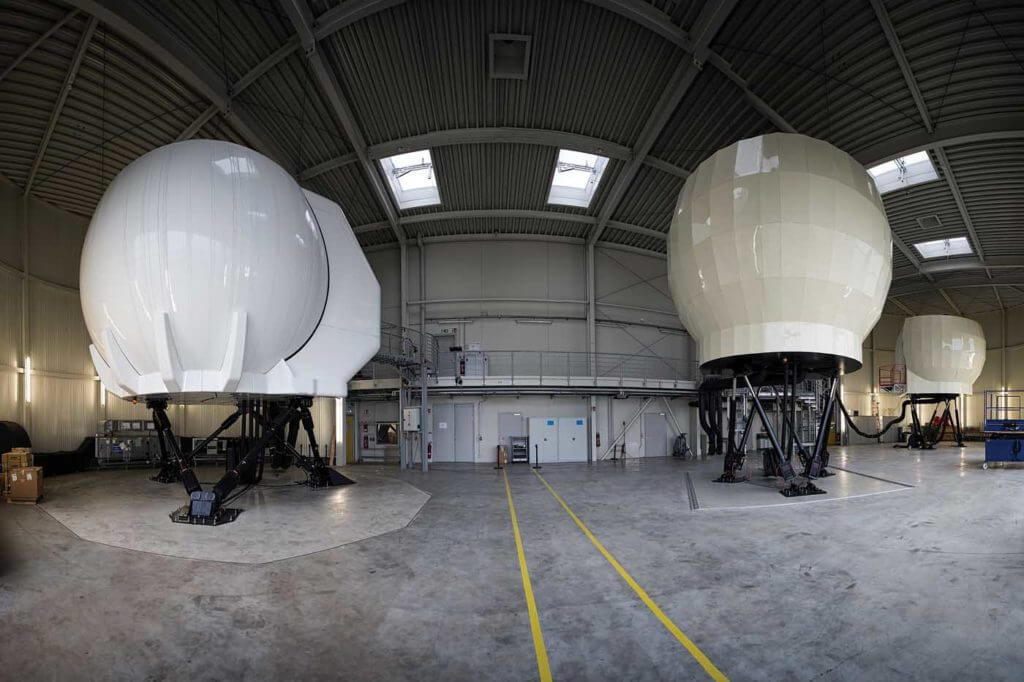
Opinions on using helicopters to improve patient outcomes were divided. Rescue flights by other agencies were too few to provide convincing data — with many ruling out the concept purely on economic grounds — but ADAC was not to be deterred. Its thorough approach brought support and interest from the aviation community, but also highlighted the need for a sustainable financial model, and a different helicopter.
In 1970, ADAC began operation of its first Messerschmitt-Bölkow-Blohm (MBB) Bo.105, the aircraft’s design having been directly influenced by its 1968 trial. By 1975, eight bases were operating Bo.105s procured by the German Ministry of the Interior, with one other purchased with funds from an ADAC public appeal. There was no going back. In the following years, systems and methods to develop helicopter air rescue into a mature public service were devised.
Today, with the exception of 12 bases served by the Ministry of the Interior, the provision of helicopter emergency medical services (HEMS) aircraft, aircrew, base facilities, and training is contracted out by each federal state in order to provide complete coverage of Germany. With ADAC having been instrumental in the system’s inception, it is no surprise that ADAC Luftrettung (Air Rescue) fulfills the majority of these contracts. As road accident survival rates have dramatically improved since the ’60s, today, it is more common for an ADAC Luftrettung helicopter to be called out for an accidental injury or medical emergency.
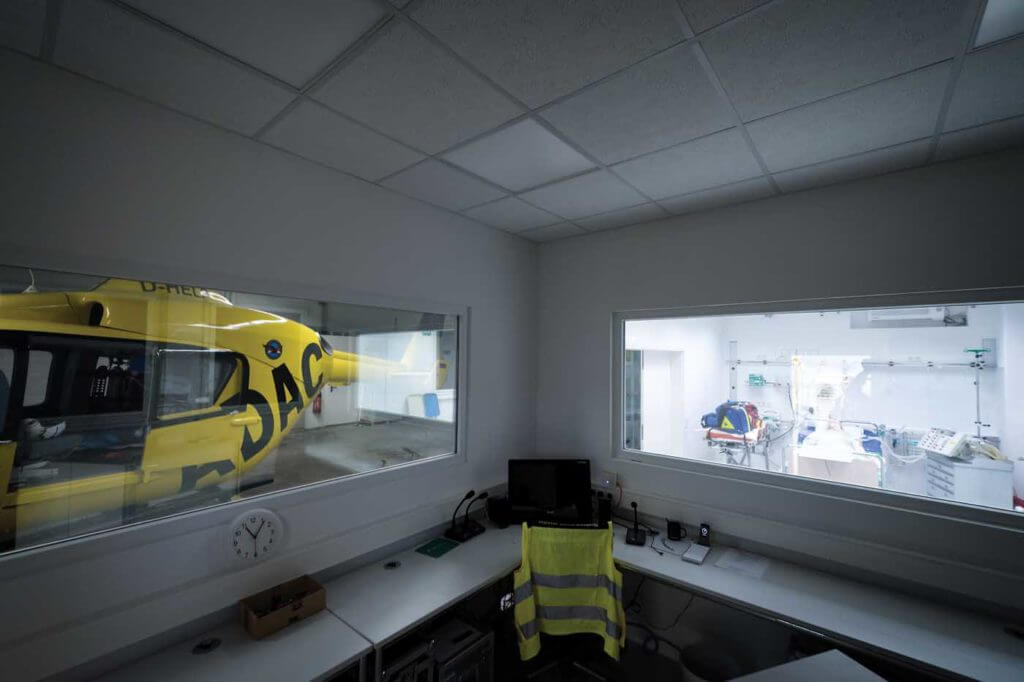
The Bo.105 proved to be a great aircraft for the HEMS mission, and served as the basis for development of the larger BK117 and then, under Eurocopter (now Airbus Helicopters), the EC135 (now H135). ADAC Luftrettung quickly adopted both, and today operates 55 aircraft in the BK117/H145 and H135 series from 37 bases.
The provision of a service at this scale demands significant investment in infrastructure, particularly given that German law stipulates the repair or replacement of unserviceable HEMS aircraft within three hours. Three major engineering support facilities under ADAC Luftfahrttechnik (ALT) complete major maintenance work, and are all Airbus Helicopters service stations. ALT also maintains its own European Aviation Safety Agency (EASA) Part-21 organization, holding several supplemental type certificates relating to HEMS.
Each rescue station is equipped with all the necessary supplies to sustain day-to-day operations and accommodate the three-person crew: one pilot, along with medical crew seconded from a local hospital. A consultant anesthetist specializing in emergency medicine (known as a notarzt) is assisted by a rettungsassistent or notfallsanitäter: non-physician emergency medical professionals who receive a high degree of training in emergency care.
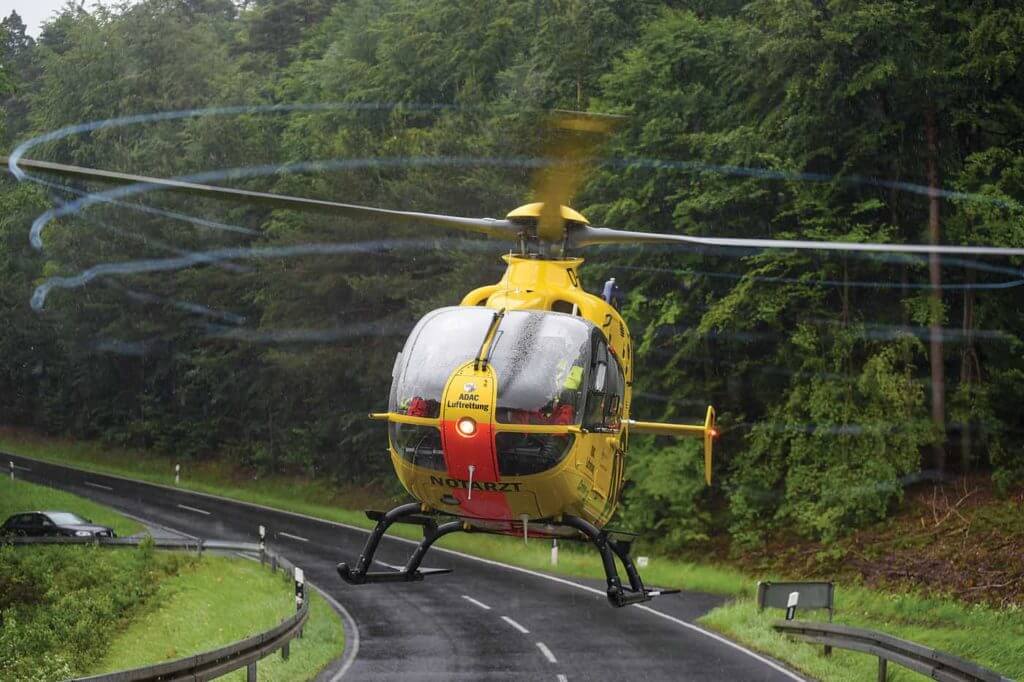
The crew are at three minutes’ notice to be airborne throughout the day from 6 a.m. (or sunrise, in the winter) until 30 minutes after sunset. Some rescue stations, mainly those responsible for intensive care inter-hospital transit, are equipped for night operations using night vision imaging systems (NVIS) and instrument flight rules (IFR). Most are day visual flight rules (VFR) operations only, although their lower visibility limit is just 800 meters (one-half mile), so they are rarely grounded for weather.
Michael Schneider, pilot and base manager at the rescue station that I visited at Aachen, said that maintaining medical cover is always the priority. “When the helicopter can’t fly, the medical crew will be on the road in an ambulance,” he explained. With each station responsible for just a 50-kilometer (26-nautical mile) radius, the response time when crews can fly is impressive. “It takes us no more than 15 minutes usually to get to the patient,” he said. “Most of our sorties are shorter, with only five or six minutes en route.”
Sharing their expertise
From plucking casualties from Alpine pinnacles or wind turbine nacelles at sea, to landing within the confines of an Autobahn junction, the ADAC Luftrettung operation treats on average 130 casualties per day and accounts for an estimated three percent of all HEMS operations globally. Operating at this tempo in such a variety of environments places ADAC Luftrettung among the world’s HEMS experts, which in 2009 led to the organization opening the world’s first HEMS Academy near Bonn in Western Germany.
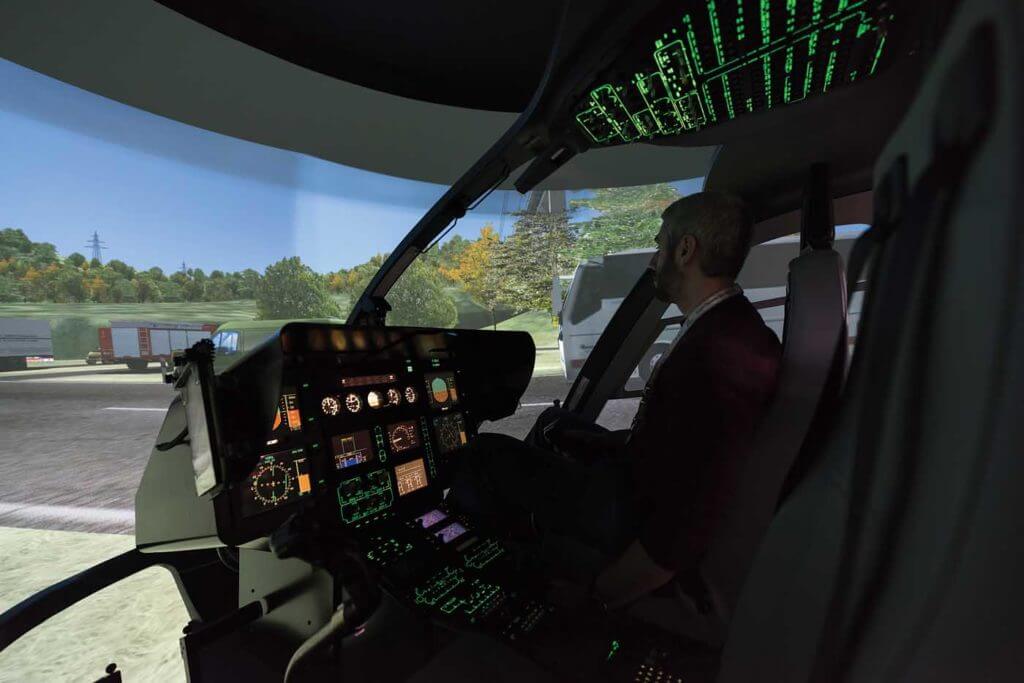
Originally established to focus on initial and recurrent training for ADAC Luftrettung crews, the ADAC HEMS Academy now attracts clients from across the globe, who come to make use of the academy’s well-developed capability to provide task and situation-based training.
At the center of the academy’s training philosophy is a whole-mission, whole-crew approach. This is born out of the recognition that the HEMS mission places a small team into situations that are simultaneously highly demanding for each of them. In order for only three people to meet these challenges, much crossover knowledge and expertise is necessary.
“It was very important to create integrated training for the whole team,” explained Thomas Gassmann, head of business development at the ADAC HEMS Academy. “We teach them situational awareness, and how to face constantly changing situations. We have full-scale mock-ups of an EC135 and BK117 situated next to an emergency shock-room with a director’s station, so we can train transport of patients and information from the helicopter to the emergency room.”

This impressive facility allows the whole team to practice loading and transferring patients, using medical simulator mannequins with the capability to emulate all manner of human malfunctions. By co-locating mockup aircraft with sophisticated medical simulators, the pilots, doctors, and paramedics who go through the academy are better prepared for the complex environments in which they actually operate. Making procedures and protocols second nature undoubtedly produces safer actions and better decisions in the huge variety of circumstances that cannot be specifically trained for.
This approach is why the ADAC HEMS Academy has also attracted external clients from outside of the air medical sector, including offshore, VIP, police, and parapublic operators. The academy now offers aircraft and instrument type ratings, NVIS instruction, and training for inadvertent entry into instrument meteorological conditions (IIMC) for Airbus EC135/H135 and BK117-C2/H145 operators worldwide, independent of their mission background.
Two full flight simulators (FFS) from QinetiQ cueSim each replicate the EC135 P2e or T2e, and the BK117C-2 (better known as the EC145), both certified not only to EASA Level A, but also by Brazilian, Argentine and Russian aviation regulators. These are supplemented with the HeliSys 135 system trainers from Boeing Peters Software, which use touchscreens to replicate the avionics and aircraft system switching to assist in learning procedures. They simultaneously display system diagrams and detailed 3D models of components, clearly illustrating the complex interrelation between systems during various phases of aircraft operation.
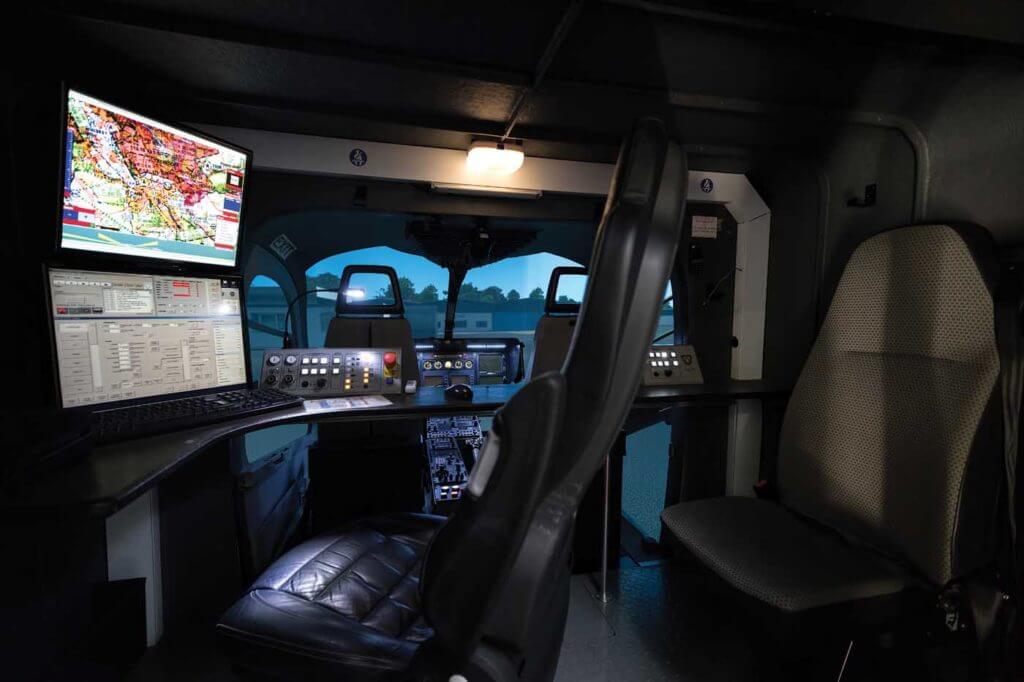
As with the HEMS-specific training, the emphasis of simulator training at the HEMS Academy is on the mission, rather than
flying technique. As Gassmann explained, “We work hard to ensure that we deliver learning experiences, whatever the student’s background. All of our training is bespoke to the individual’s experiences and scenarios are customized to ensure that they see something that they can learn from, and that they never see the same situation twice.”
Into the future
In 2014, ADAC Luftrettung replaced its legacy BK117 B2s and C2s with the Airbus Helicopters H145, a development that Gassmann described as a “game changer.”
“The H145 provides more power, and more performance,” he said. “It is mainly used in intensive care transport where we need to take more equipment, or in offshore and mountain environments. When you’re hovering here in the mountains at 2,500 meters [8,000 feet], it’s good to know you have OEI [one engine inoperative] performance.”
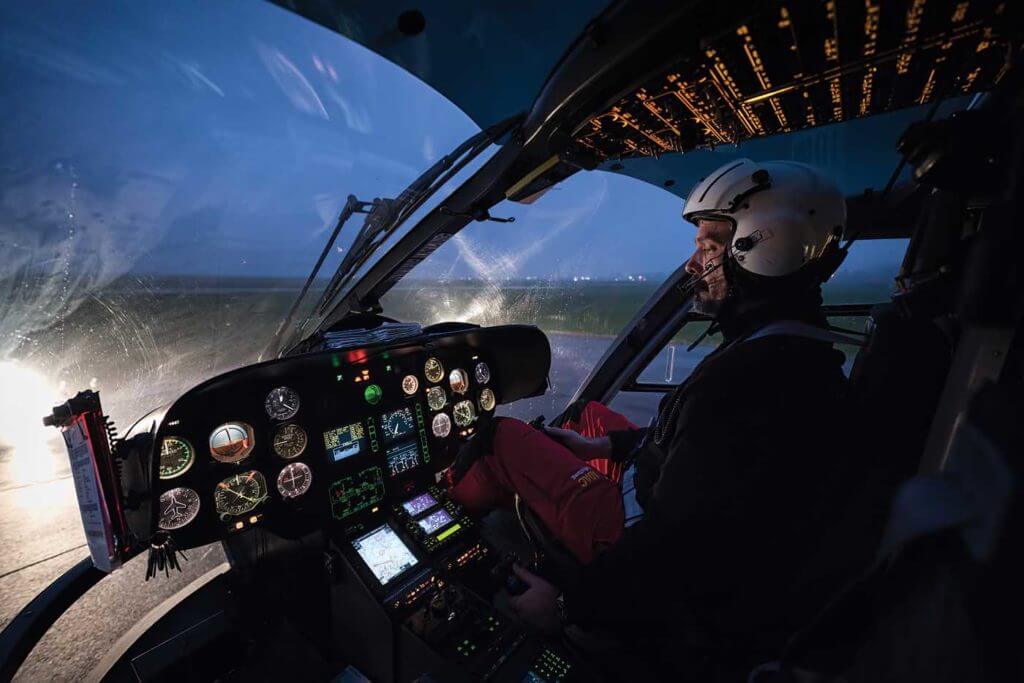
The H145 clearly represents a significant advance from legacy BK117 variants, most obviously in the incorporation of the Helionix avionics suite. Continuing to rely on the existing FFS modules was not an option for the ADAC HEMS Academy, so it began the process of acquiring a simulator that would represent as much of a step forward in synthetic training as the new aircraft did in the air.
The specification called for certification at EASA Level D, the highest possible fidelity, but the academy also needed to incorporate a level of fidelity in the scenarios and environmental system that was, at the time, not available. It was faced with having to build its own simulator, and with most aircraft manufacturers closely guarding their flight data as proprietary intellectual property, that meant a rigorous flight test program simply to generate the simulation data model. After partnering with Reiser Simulation and Training, the two companies set about the challenge.
The levels of flight simulation fidelity incorporate a vast array of criteria that must be met within specific tolerances: from the visual system through to vibration, control feel, and system behavior under specific conditions. While achieving the Level D certification was important from a commercial aspect, at least as much effort was poured into creating a system specifically to meet the requirements of the ADAC HEMS Academy’s training philosophy. Every switch and circuit breaker is functional, allowing the instructor to create complex compound malfunction scenarios that more closely mirror the progression of real-world emergencies.
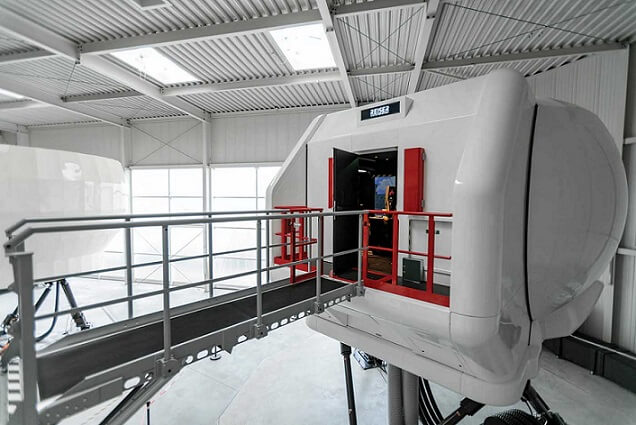
“We needed it to be Level D to attract outside clients, and to conduct type-specific training,” Gassmann told me. “Just as important to us was the ability to create and modify scenarios, and those things are not part of the certification process.”
Michael Happel, head of training at the HEMS Academy, demonstrated the creation of a basic scenario on the touchscreen briefing system. These discrete systems allow several instructors to be simultaneously creating scenarios, briefing students, and operating the simulator, resulting in more efficient sim usage. The software is mirrored on an instructor operating system within the simulator itself, meaning that scenarios can then be altered, or even created from scratch, during training.
Moving into the H145 simulator, Happel guided me through a HEMS scenario. Given that the German aviation authority, the Luftfahrt Bundesamt (LBA), had just approved certification at Level D — and having no personal experience whatsoever on the H145 — I elected to take their word that the flight dynamics were up to spec. I concentrated instead on the scenario modeling.
With a 240-by-80 degree field of view from an array of 15 Barco projectors, the resolution and graphic fidelity gave more than enough visual reference to provide complete immersion. After I avoided a hilltop shower en route to the scene, the software was able not only to create an authentic-looking truck wreck, but also to cause dynamic traffic jams that necessitated real consideration in landing-point selection. The weather was poorer now — the shower had worsened and been blown directly over our route — but conditions were still easily VFR, at least until we began our transit to the hospital.
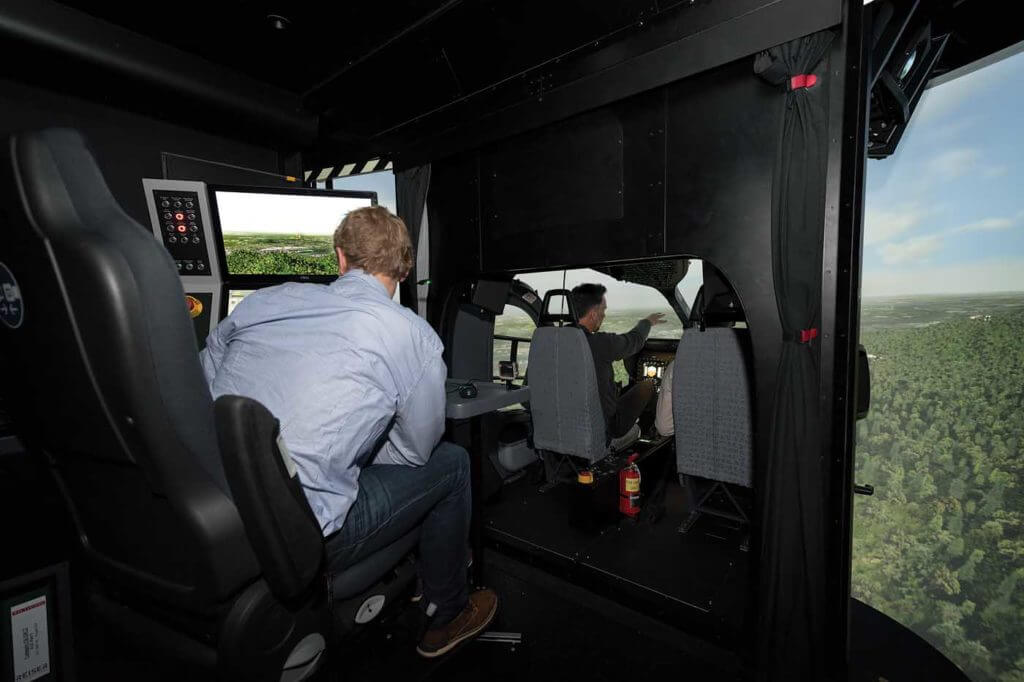
At this point, in the fading twilight, it became hard to discern what the visibility actually was and where precisely the indistinct cloud base began. As I negotiated the high ground around the hospital, it struck me that the visual engine handles weather superbly. It was exactly the kind of deceptively borderline conditions in which only a very subtle distraction would be necessary to risk an inadvertent entry into IMC, without obvious, sudden, and unrealistic degradations to prompt an abort decision.
Modeling such marginal conditions is essential to this training approach, predominantly because decision-making is not tested when the correct action is obvious, but when the situation is ambiguous; when circumstances rest on a boundary between go and no-go, or conditions deteriorate insidiously. A thorough knowledge of the rules is essential, of course, but decisions in these circumstances must be made based on sound judgment. Training of this nature helps both the individual and the organization, as exposure to marginal scenarios will very quickly identify gaps in standard operating procedures or operational policy.
Pilots, doctors, and paramedics do not attend the ADAC HEMS Academy to learn their profession, but how to apply it specifically. The aim therefore is not to train procedure itself, but to rehearse situations, make mistakes safely, and learn. It is a training mindset common to many elite operators, from special operations forces to high-performing sports teams. Familiarizing team members with the situations in which they will operate commits the correct routines and actions, however small, to their subconscious. Doing so frees up their conscious mind to solve complex problems and make difficult decisions that are highly situation-dependent, rarely repeated, and impossible to predict. It is a hallmark of highly professional training.
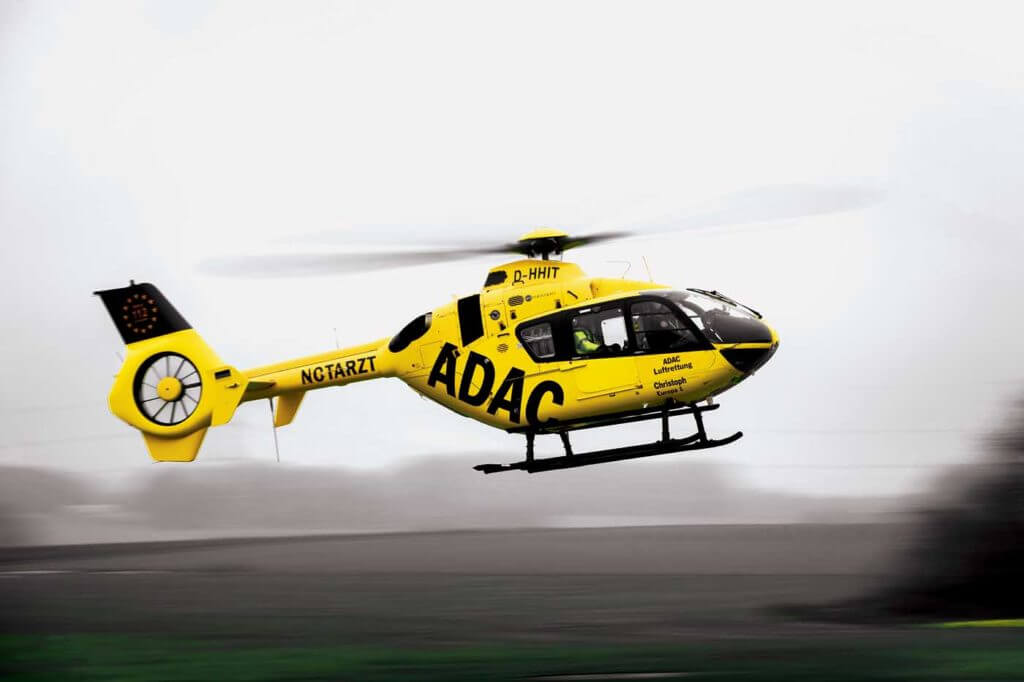
At press time, the ADAC HEMS Academy was scheduled to open its H145 FFS for its first students in the second week of January 2018. It was clear they would be in very good hands.





